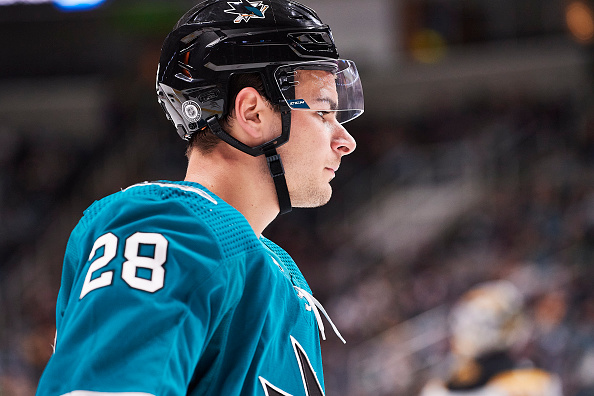There is one essential trade the San Jose Sharks need to make. It is to trade their top line. All of it, as a unit.
The reason for this is clear and covered in depth elsewhere, but it goes like this: the Sharks do not have the talent to compete at a high level now. Coupled with multi-year salary cap problems (older players on large, long-term deals), the Sharks are unlikely to become highly competitive over the next few seasons. So, instead of making moves that extend this mediocrity, focus on building a team capable of sustaining success. It may take four years to make the full turn, but it is the right choice.
To become good and sustain success, the Sharks need to acquire a significant number of premium draft picks. This trade meets the objective. The Sharks trade Timo Meier, Tomas Hertl and Alexander Barabanov for six first-round draft picks.
Both sides of the trade are shocking. One side sees a staggering amount of talent departing, the other side pays for it with a major chunk of future opportunity. For the acquirer, this is going ‘all-in’ at another level. But it isn’t a gamble.
Analysis shows this is fair for all – assuming the Sharks trade partner really wants a Stanley Cup.
San Jose Sharks Trade Deadline: Essential Trades The Sharks Need To Make
As the trade deadline approaches, Stanley Cup contenders typically scour the league trying to find a key player who can take them from contender to champion.
This is not that trade.
Historically, teams think small. One player, maybe two, to address a specific weakness. Tyler Toffoli is a recent example. The Calgary Flames, the league’s hottest team, added Toffoli in a recent trade. He is a good player, but is he enough to bring a championship to Calgary? Consider it unlikely. Calgary made an incremental improvement.
This trade is a new way of thinking. It literally drops in a new top line (or second line for teams with an elite top line) and benches their fourth line. It transforms a team. This is the essential trade the San Jose Sharks need to make. This is also the essential trade a team needs to make to give themselves a massive advantage in pursuit of the Stanley Cup.
Case Study: New York Rangers
Take the New York Rangers as an example. Their 10-12th highest scoring forwards have combined for eight goals and 25 points. The Sharks’ top line has 54 goals in 53 games and 122 points. Nearly a goal-per-game difference. A goal per game is roughly the difference between the league’s best team and the league’s middle of the pack. Even defensively, the Sharks line is much better the Rangers line.
Would this trade put the Rangers over the top? Very likely. The Rangers have a respectable offence, elite goaltending and a strong group of blueliners. What do they lack? Enough offence. The Rangers are 21st in goal scoring, 3rd best in goals allowed.
The Rangers’ top three scoring forwards have combined for 68 goals. So far, so good.
Their second trio has netted 34. Not as good. The third trio, just 16 and the fourth trio, only 8. Combined, the bottom three trios have 58 goals. The Sharks trio have netted 54, nearly the same total as the Rangers’ second, third and fourth group combined!
This trade moves the Rangers from a slightly below-average scoring team to one of the best in the NHL, on par with the Colorado Avalanche and Florida Panthers. They become a top-three scoring offence coupled with a top-three defence. And the dominant team in the Metropolitan Division.
The Rangers have another major consideration. Next season, Norris Trophy-winning defenceman Adam Fox sees his salary cap hit rise by over $8.5 million, taking up most of the team’s open cap space. The Rangers have much more room to make a major deal this season than they will next.
Does this trade make sense for the Rangers, a team with a lot of young talent already in the system? Quite possibly.
Case Study: Boston Bruins
The case for the Boston Bruins is similar in some respects to the Rangers, different in others.
Unlike the Rangers, the Bruins are in the midst of a long, impressive run. The team is led by future Hall-of-Famer Patrice Bergeron. He is 36 and in the final year of his team-friendly deal. Linemate Brad Marchand is 33. When they get their playoff berth this season, it’ll be their 13th in the last 15 seasons. Their window with Marchand and Bergeron (second and third on the team in scoring) has a modest number of seasons left – this may be their best opportunity. The Bruins can trade a pair of forwards who command nearly $5 million in cap space and who’ve potted just nine goals. This gets the deal done.
The Bruins face stiff competition within their division. Though they’ve been good for a long time, they’ve only made it past the second round once since their 2013 Cup win. Boston already has a superb top line and strong second line. Adding the Sharks top line gives the Bruins three lines capable of playing nearly an entire 60-minute game – a massive competitive mismatch.
Sharks Trade Deadline Considerations
In any trade deadline move, the biggest issue is not the talent of the player being acquired; it is whether the player will adapt to the system quickly enough. That is, will they find chemistry with teammates? Or will the acquired player zig when they are supposed to zag? Most trade deadline moves have this issue, and, as a result, are suboptimal. These three players have chemistry with each other. The biggest downside risk is eliminated.
[pickup_prop id=”9782″]
How the Deal Adds Up: Player Value
What is the nominal trade value of each player?
• Hertl is worth a first-round pick. And a second-round pick
• Meier is worth two first-round picks
• Barabanov is worth a third-round pick
This adds up to three first-round picks, a second and a third. Combine that second and third and call it another first. This is a bit generous, but not by much. So far, the value is four first-round picks.
How the Deal Adds Up: Salary Cap Value
Next are the salary cap implications. The Sharks can and should retain salary. Meier has another season on his $6 million annual deal. Hertl’s deal ends after this season, he makes a bit under $6 million. Barabanov makes $1 million and his deal also ends after this season.
Barabanov is the least known of the trio. A fair value contract would come in around $3 million per season (34 points in 54 games for the Sharks so far). Hertl is an $8 million player and Meier is a $9 million player. As a line, the trio is worth about $20 million in salary-cap space annually.
The team on the other end will get one partial season and one full playoff season from Hertl and Barabanov. They’ll get one partial season, one full season and two full playoff seasons from Meier.
What will this cost? Assume the Sharks eat half the salary cap on Meier and Hertl, none on Barabanov. The total cap cost is a bit over $7 million. Their value is mostly based on what they bring in the playoffs, which is $29 million worth of playoff value.
A first-round selection is worth about $10 million in cap space. There is precedent here. Some may recall Patrick Marleau was traded for a first-round pick to the Toronto Maple Leafs so the Leafs could save $6.25 million in cap space. The deal proposed here brings $22 million of cap value (nominal player value – actual cap cost), essentially the equivalent of two first-round selections.
Add these two first-round picks to the prior four for a total of six first-round picks.
How The Deal Adds Up: Additional Value
The essential trade the San Jose Sharks need to make it fair for all parties.
Still, there is potential for more value.
• The most important element is one mentioned earlier, this is a very rare trade that is risk-free from the player chemistry side. By taking a large risk to essentially zero, value is added.
• The acquirer can gain cap savings from the players the Sharks get in return. The Sharks can take on their trading partner’s worst contracts – negative value players – on shorter-term deals. This creates (or frees up) cap space for the acquirer to do even more.
• Draft picks have a time value. That is, the same round selection is worth more if it is sooner. Take an extreme example. Would a general manager acquire a second-round draft pick in the upcoming draft and give up a first-round draft pick in 30 years? Of course, they would. This is an example of (albeit extreme) the time value principle.
Assume the time value is four spots per year (that is, the equivalent of going from 38th overall to 34th overall a year later), a draft pick eight years out is worth 32 spots, or one round higher.
[pickup_prop id=”19119″]
The first-round picks will go out at least six years and perhaps more (the six selections can spread out over 7-8 years). This means the value of the longer-dated selections is worth somewhat less than the earlier-dated picks. Because of the time value effect, the deal is closer to five first-round and one second-round selection.
• There’s one more potential from this trade. It might discourage some competitors from making their own trade. A competitor’s general manager might decide this is not their year to go all-in on a Cup run. If the Rangers made the trade, it’s possible that their division rival, the Pittsburgh Penguins decide not to upgrade this season.
A Paradigm Change
Most teams are looking for the ‘get us over the top’ trade at the trade deadline. “Get the right player who’ll get us a Stanley Cup”. This paradigm nets a ‘Tyler Toffoli’ along with the hope that he’s just the right upgrade to win a Cup.
The trade here is a different paradigm. This is a ‘crush the competition’ type of trade. It is fundamentally different. No trade can assure a Stanley Cup, but inserting an entire elite line will make an enormous and unprecedented difference. The essential trade the San Jose Sharks need to make is a new paradigm.
Many teams think they have a shot at the Stanley Cup. For this season’s Stanley Cup run, a team that acquires these players from San Jose will have a roster with $20 million of talent for a cap cost under $5 million. Next season, $9 million of talent for $3 million. These are enormous advantages.
The asking price is steep, but the value is real.
The Main Question
As the Sharks know, having a very good team, even for a very long time, is no guarantee of a Stanley Cup victory. The team which acquires these three Sharks will be an elite team. It will hold an unreasonable advantage over every other team in the tourney this season and a meaningful advantage next season.
Any team interested in this sort of deal must ask themselves some questions: Is it worth parting with all these high draft picks for a massive advantage in the Stanley Cup playoffs (both this season and next)? This is the essential trade the San Jose Sharks need to make. Should our team do this deal with San Jose? What if one of our competitors makes this deal?
Answer these questions with a different question: It is the Stanley Cup, how bad do you want it? If the answer is yes, then go for it. It might be worth the deal.
Main photo:
Embed from Getty Images






